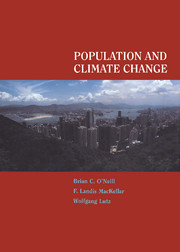Book contents
- Frontmatter
- Contents
- Foreword
- Preface
- Authors and Contributors
- Acknowledgments
- PART I
- PART II
- Appendix I Fertility and Mortality Assumptions for IIASA Population Projections
- Appendix II Household-level Economies of Scale in Energy Consumption
- Appendix III Population in Major Climate Change Assessment Models
- References
- Index
Foreword
Published online by Cambridge University Press: 23 December 2009
- Frontmatter
- Contents
- Foreword
- Preface
- Authors and Contributors
- Acknowledgments
- PART I
- PART II
- Appendix I Fertility and Mortality Assumptions for IIASA Population Projections
- Appendix II Household-level Economies of Scale in Energy Consumption
- Appendix III Population in Major Climate Change Assessment Models
- References
- Index
Summary
For most of its 25-year history, the International Institute for Applied Systems Analysis (IIASA) has conducted important original research in climate change and in demography. It is therefore particularly appropriate that scientists from this institute undertook the multidisciplinary research project that has resulted in this book.
We can expect that climate change, both natural changes and those resulting from a variety of societal activities, will lead to changes in demography. In turn, demographic changes could influence climate. Population and Climate Change is the first book to delve deeply into the intricate relations between shifting climates and population changes such as where people live, where they move to, how they propagate, and how they die. It is also the first book to take a dispassionate, scientific look at how population affects climate change and society's ability to adapt to it.
History is replete with examples of climate change influencing population. Twenty thousand years ago, the amount of water stored in continental glaciers reached its maximum. As a result, the sea level dropped more than 100 meters, exposing parts of the ocean floor as dry land. Shallow ocean straits became land bridges; one such formation, the Bering Strait, served as a migratory route allowing Asiatic nomads to cross over to North America. This early example illustrates how natural climate change influences migration.
The impacts of climate change were particularly noticeable during medieval times. Lack of sanitation and modern technologies left people vulnerable to even small changes in the prevailing climate. In some sense, the vulnerability of people in these early times provides guidance as to the vulnerability of people living in today's developing world.
- Type
- Chapter
- Information
- Population and Climate Change , pp. vii - xPublisher: Cambridge University PressPrint publication year: 2000

